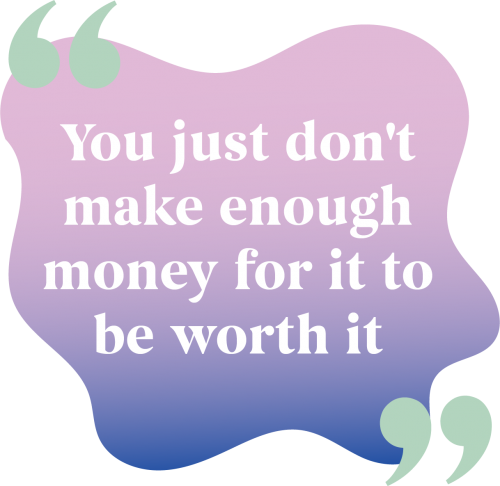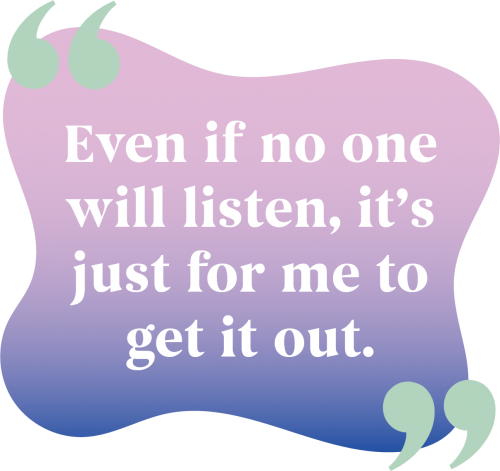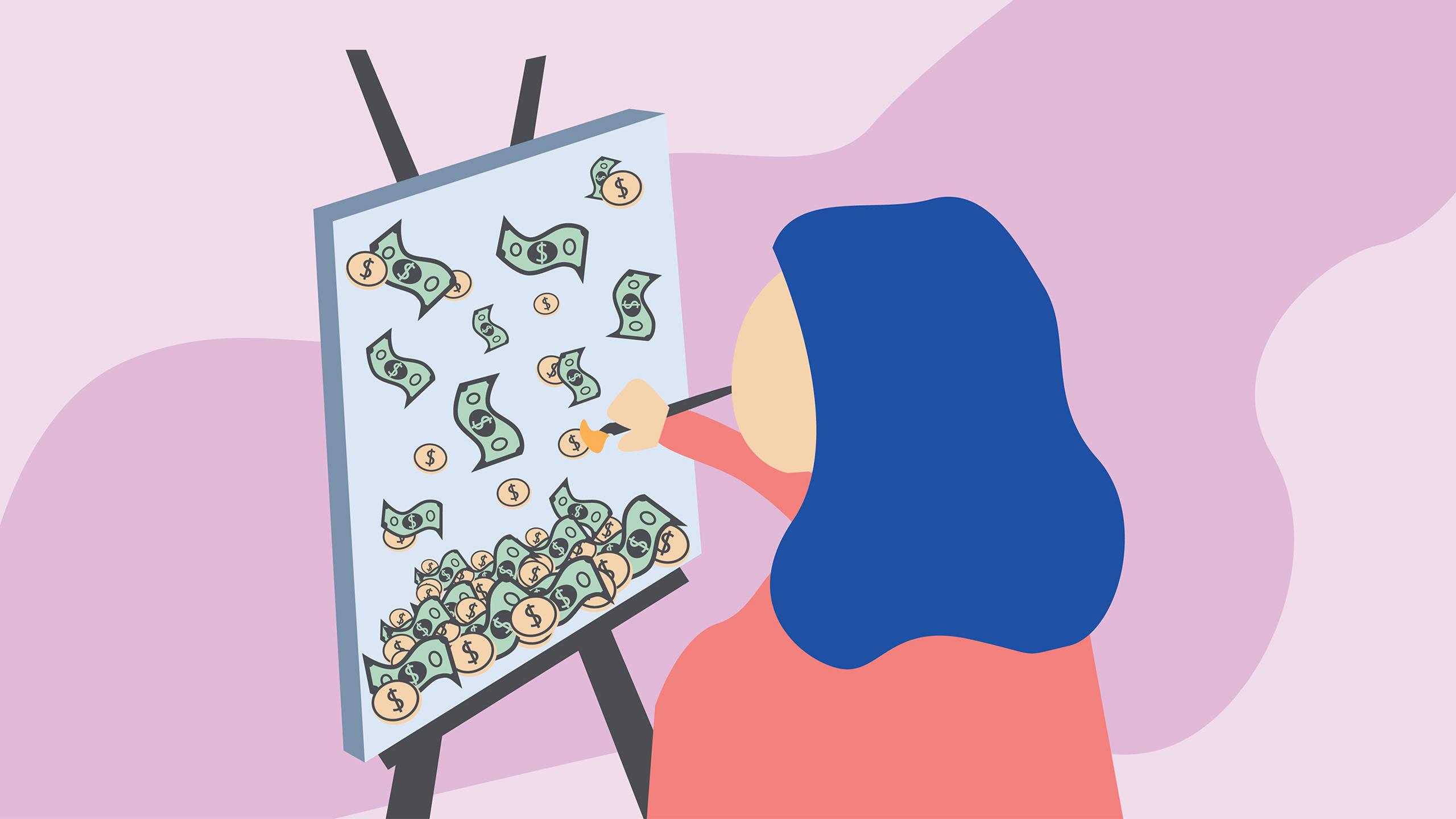When hobbies become a source of income, do they have to stop being a source of fun?
Words by Emma Moore
Illustrations by Sabrina Kauk
AS A FULL-TIME film studies student with part-time jobs at the Ryerson Students’ Union Trans Collective and the Sheldon & Tracy Levy Student Learning Centre (SLC), Ezra Li doesn’t have much time to work on orders for his Etsy shop where he sells pins and patches. Still, he’ll spend an entire day or two in a month cutting plastic sheets, curing them and attaching pin backings—all by hand—before shipping the pins out twice a week.
“I want to rip my hair out,” says Li. “It’s definitely like an errand.”
While the work is tedious at times, it’s necessary—he needs the extra income.
When Li started studying at Ryerson, he quickly realized the expenses that came with university simply can’t be covered with a part-time job. In first year, he set up his Etsy shop, selling pins and patches in order to help cover his tuition, rent, and other expenses. Running his business online allows him to make some much needed extra money while maintaining flexible work hours.

In a 2018 study by the Henley Business School, half of the people surveyed started a side hustle for the same reason as Li—they needed an extra source of income. The study also found many of the same people who relied on a side hustle were younger, with 34 per cent of respondents aged 16-24 reporting they have a side hustle.
Li is not alone in worrying about making ends meet for university. According to the 2015 National Graduates Survey by Statistics Canada, 60 per cent of Ontarians graduating with a bachelor’s degree have outstanding debt, with the average debt owed being $30,000.
Entrepreneurship is becoming more accessible—considering the cost of starting a business has decreased significantly in the past 20 years—says Sean Wise, an associate professor of entrepreneurship at Ryerson. A new business venture might have once required a major investor and millions of dollars to launch, but nowadays it may cost less than $50, Wise told The Eyeopener via email.
Beyond matters of money, the study from 2018 found that 73 per cent of people who engage in a side hustle are motivated by their passion.
When Li first started making pins, he says he did it mostly for himself. The idea that he was the only person on the planet that had that specific pin made it feel special for him. But when he started to sell his pins, he quickly found that making large batches of identical products was not creatively stimulating.
Being a full-time student and working two part-time jobs means that his Etsy shop often takes a back seat to his other responsibilities. Li says his work is rarely creatively fulfilling, because a time consuming product just wouldn’t be profitable. “You just don’t make enough money for it to be worth it,” says Li.
Li specifically set up his profit margin so that it’s as large as possible for the amount of labour he puts in. His products sell for around $10 and are small enough to ship in an 50 cent envelope.
While the work can be challenging, Li says the additional income and positive reviews customers leave make it worth it. People have left comments and reviews on his pronoun pins, saying they’ve helped them with their gender dysphoria. Li says he never expected comments like these, but is happy to have been able to help someone embrace their identity.

FTER THE CHRISTCHURCH mosque shootings in 2019, incoming journalism student Maryam Azzam started creating digital surrealist collage art using Photoshop, channelling the pain she felt as a Muslim artist.
“I didn’t know what to put out because I’m not in New Zealand, I can’t go photograph the mosque, right? So I was like, if I can’t take a picture of it, I’ll create one.”
When she posted the artwork on Instagram, people were sharing the post on their stories, commenting with messages of solidarity—it garnered much more engagement than her photography ever had. She even received a message from someone who lives in Christchurch, expressing their appreciation for her global act of solidarity through art.
Initially, Azzam says she wasn’t charging nearly enough for her artwork. She recalls an instance where she charged just $20 for a piece that took her eight hours to create—not even coming close to making minimum wage. She says she believes artists who are beginning their side hustles should learn to value their art. Creating art can be incredibly gruelling because it’s new every time and every client wants something different. “Your clients can be extremely demanding sometimes, and it’s completely understandable because they have a vision and you’re trying to execute it,” said Azzam. But she wants artists to be paid what they deserve for their time and effort.

Azzam still uses Instagram to market her artwork, but mainly uses the freelancing platform Fiverr to find clients. Fiverr connects people who provide services to people who have skills in that particular field. Azzam’s gig is usually making cover art for musical artists’ albums and singles.
Using digital platforms to market freelance work is a tactic that’s on the rise. According to a 2016 McKinsey Global Institute report, 15 per cent of independent workers use digital platforms like Fiverr and Instagram to market and sell their work—and this usage is growing rapidly.
The flexibility of Azzam’s side hustle allows her to focus on school when she needs to, like when she has to study for her midterms. She can put her Fiverr account on pause, or announce that she isn’t taking any more requests on Instagram.
“You can’t do that with a regular part-time job. You can’t just be like, ‘Hey, guys, I need a break, let me come back in a couple of weeks.’ That’s not how it works.”
When she began using Fiverr, Azzam stopped making art for herself, but is now getting back into the groove. She finds it helps prevent art from feeling like work.
Steve Gedeon, chair of the Ryerson Entrepreneur Institute, wrote in an email to The Eye that the purpose of a side hustle is not just about pursuing financial gain but about experimenting with new things and doing something that you love. In a 2019 OnePoll survey, 41 per cent of respondents said they started their side business to spend more time doing what they enjoy.
At home, Azzam often finds herself frustrated by her family’s conservative beliefs, feeling as though she can’t say what she wants. She creates a balance between her hustle and hobby by incorporating her political views into the art she creates for herself.
“If something affects me, or if I want to say my piece on it, even if no one will listen, [it’s] just for me [to] get it out.”

UISI LIU ONCE earned only $5 after tattooing someone for three hours straight. Not only was her time wasted, but she also suffered cramps in her hand from holding the needle for hours.
This wasn’t the first time Liu felt under-compensated for her work.
The first-year film studies student has taken part in physical markets like the SLC Christmas Market in 2019, where she sold her digital prints. While putting her art on display did help her reach a wider audience, not many people actually bought her work. She says she only made around $40 in profit from the market.
Instances like this leave her feeling less motivated to tattoo and draw. Sometimes when she receives commissions, she’ll be slow in replying to them. While some people will be thankful for the work, others have tried to bargain with her for a lower price.
Wise says entrepreneurs like Liu often decide to sell their work for less—but not because they are undervaluing their work. Instead, he says it’s about adapting to their new business.
“The first sales of any new venture are acts of exploration more than monetization,” he says.
Despite her frustration, Liu says the connections she creates with people through her art help her stay motivated. She feels her purpose as an artist is to tell stories through her art, and that enthusiasm keeps her inspired to continue creating.

OBIN KADIRGAMAR BEGAN creating fan art for fun. When his part-time work schedule changed to limit the hours he could work, his friends recommended he begin to do commissions. As a full-time student, he needed to find an additional way to financially support himself.
When he ended up posting his first commission on Twitter, people started reaching out, asking him to draw specific characters for them. Kadirgamar now primarily uses Twitter and Instagram to promote his work and collect commissions, and says it’s not a point of stress for him.

He found that some clients would tell him he is underselling his art and would give him more money after receiving it. “I have had people who are willing to pay more than what I was asking for,” he says. “That is a really humbling and jarring thing, especially when you’ve convinced yourself that your stuff isn’t that good.”
Kadirgamar found that people within fandoms tend to be supportive of him and understand when he’s busy. When he doesn’t have enough free time to work on his commissions, he’ll put them on hold and tell people he’s not accepting anymore. He recognizes he needs to establish this boundary to enjoy creating his artwork.
According to Wise, burnout comes from poor balance. Among other factors, when there is too much work to do and too little time to do it, burnout happens, says a 2001 study in the Annual Review of Psychology.
Wise also says making sure the task is something you are ardent about can help mitigate the negative effects of burnout. In fact, many people who have a side hustle report the work they do makes them feel happier—69 per cent of people surveyed in the 2018 Henley Business School study say they feel more positive about life because of it.
“When I get commissions for a fandom that I’m personally involved in, I feel like it’s both a job and a passion project,” said Kadirgamar.












Leave a Reply